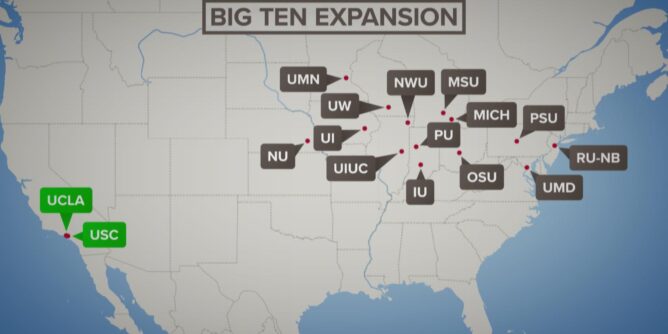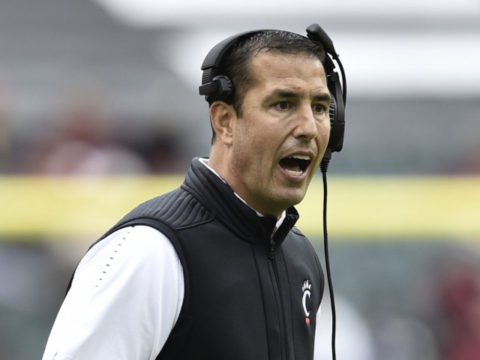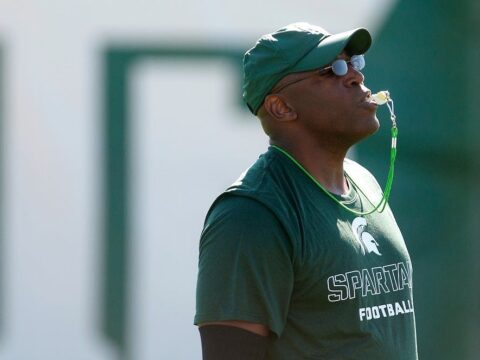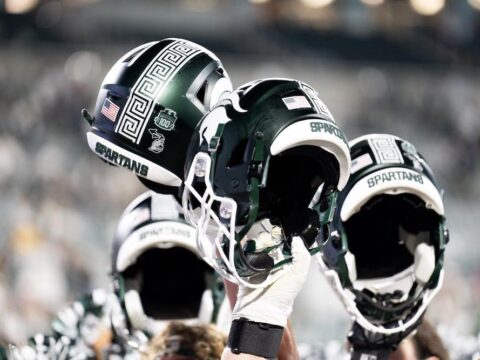
Ever since we learned that UCLA & USC were joining the Big Ten, there have been plenty of opinion writers who fail to see the benefit of expansion, and Jemele Hill is one of those writers.
In fact, Hill wrote a piece titled: “College Football is Cannibalizing Itself”, but what in the world does that mean?
Hill tries hard to make the case that expansion will destroy historic rivalries, while long distance travel will compromise academics, and finally she comes to the grand conclusion that expansion is simply about making money.
But C’mon, that’s a lazy narrative, isn’t it?
In other words, Hill is suggesting there is no overriding benefit to expansion and therefore it’s just about making money?
It seems to me that Hill (and others) are rushing to judgement without gathering all the facts. Has Jemele Hill studied Big Ten history and its historic expansion over the past 130 years? (We’ll look at Big Ten expansion shortly).
I think history teaches us the latest expansion is simply a natural step in evolution.
In fact, it is highly likely the Big Ten will add 4 more teams after UCLA and USC, thereby forming a 20 team Super Conference which will span the continental US from coast to coast while representing every time zone…and no, the sky isn’t falling.
After all, expansion is a natural step in evolution, and it’s not markedly different that the evolution of the telephone from Landlines…to Cell Phones…to Smart Phones and all the iterations in between. As we look back on the evolution of the phone, in 2022 who wants to be tethered to a Landline as the only means of telephonic communication?
I’m not a visionary, but I always thought the formation of Super Conferences was inevitable, but I just didn’t know when or how, but expansion is natural, and I foresee an exciting new future.
Evolution of the Big Ten:
Let’s remember, evolution has been a part of the Big Ten from the beginning.
The conference was originally formed in 1896 with just 7 schools and it was known as “The Western Intercollegiate Conference”. The original 7 schools included University of Chicago; Illinois; Michigan; Minnesota; Purdue; Northwestern and Wisconsin.
Then Indiana and Iowa were added in 1899, and finally Ohio State was added in 1912 thereby bringing the total to 10 schools.
The Western Conference was as much an Academic coalition as it was an athletic conference. It brought together some of the finest academic institutions of the industrial Midwest.
Nevertheless, University of Chicago was conflicted regarding their mission between academics and athletics and in 1939, University of Chicago terminated Football.
Then Chicago officially withdrew from the Big Ten in 1946, thereby paving the way for Michigan State.
Yet, prior to leaving the Big Ten, University of Chicago Football (The Maroons) were a formidable force under the guidance of Amos Alonzo Stagg. UC compiled a record of 227-112-26, including 7 Big Ten Championships and 2 National Titles in 1905 and 1913 respectively.
UC was also a force across the athletic landscape as well, but UC President, Robert Maynard Hutchins was not a fan and decided to terminate football, and immediately below are a few of Hutchins famous quotes that give us a measure of the man and render it no surprise that he decided to terminate football:
“…we Americans are the only people in human history who ever got sport mixed up with higher education”.
And this quote: “Athleticism is not physical education but sports promotion, and it is carried on for the monetary profit of the colleges through the entertainment of the public…” (Jemele, are you listening?)
But Hutchins most endearing quote in a curious way was this. When asked if he (Hutchins) ever participated in recreational and/or physical activity, Hutchins said: “Whenever I get the urge to exercise, I lie down until the feeling passes away”.
Clearly, Hutchins was not a fan of athletics and so he terminated Football at UC.
Meanwhile John Hannah, the visionary President of Michigan State College which later became Michigan State University, gleefully took the baton and agreed to replace UC as a member in the Big Ten. Hannah forever believed that athletics enhanced the college educational experience.
In fact, Hannah used Football as his calling card to lobby for support with legislators as well as to seek financial support from charitable donors to transform Michigan State into one of the Top 10 largest Universities in the world by the mid 1950’s.
Clearly, Hannah and most other Presidents of the Big Ten embraced a more positive attitude regarding the relationship between Academics and Athletics than did Hutchins…and hence, Big Ten expansion has continued.
Super Conference:
So, now we have the makings of a Big Ten Super Conference.
In the past 30 years, the Big Ten has evolved from 10 teams to 14 teams and here is how the expansion took place:
The Big Ten expanded to 11 teams with the addition of Penn State in 1993…then Nebraska was added in 2011 making it 12 teams…and then Maryland and Rutgers were added in 2014 making the Big Ten a 14-team conference.
Of course, soon, the Big Ten will evolve to 16 teams with the addition of UCLA and USC…and then I predict there will be the likely addition of Oregon and Washington which would bring the Big 10 to a total of 18 teams.
But wait, there’s more…
While the Big Ten is filling in geographic gaps and lucrative markets, I predict Colorado and Utah will also be added from the PAC 12 because they represent the mountain states, and if that were to occur (and I’m betting it will) then the Big Ten will become a 20 team Super Conference spanning the continental US from East to West and filling in every time zone (a media scheduling delight).
My premise is hypothetical of course, and there are no certainties that Oregon, Washington, Colorado, and Utah will be added, but expansion is underway, and expansion must be coherent to be successful, and that fact is clearly understood by Big Ten AD’s, media executives including but not limited to BTN, ESPN and Fox Sports, and of course Sponsors such as Buick and others who pay the freight.
So, I am betting those 4 teams will be added and in so doing, the Big Ten will control 3 of the biggest media markets in the country, including but not limited to NY & NJ…Chicago…and of course, LA.
Moreover, the addition of 4 teams from the Mountain and Pacific Time Zones would dispel Hill’s argument regarding consistent problems brought about by cross-country travel, and it would also throw out the argument regarding the loss of regional rivalries.
After all, the Big Ten is not about to add UCLA and USC on the west coast and leave them on an island some 1500 miles from the nearest Big Ten outpost in Lincoln, NE, so the likely additions of Oregon, Washington, Utah, and Colorado anchoring the western states are the logical candidates for expansion.
But let’s not forget, Stanford and Cal stand by as possible alternatives. Nevertheless, I predict Oregon, Washington, Utah & Colorado will be added for geographic diversity while adding those 4 schools would also achieve robust representation in terms of academics and athletics as well.
Of course, games are played on the field and pursuant to my premise of a 20 team Super Conference, I foresee 4 Big Ten Divisions spanning the continental US and if that occurs, here is how I foresee those Divisions aligning into 4 divisions of 5 teams each.
Hypothetical Big Ten alignment:
East: Maryland, Rutgers, Penn State, Ohio State and Michigan (or Michigan State)
Midwest: Michigan State (or Michigan), Indiana, Purdue, Illinois, and Northwestern
Heartland: Wisconsin, Minnesota, Iowa, Nebraska, and Colorado
West: UCLA, USC, Oregon, Washington, and Utah
There are various iterations of alignment of course, but in terms of regional groupings, the preceding is totally viable.
Pursuant to my hypothetical, each team would play the other teams within their respective division, and then play 2 teams from each of the other Big Ten divisions (6 crossover games if you like) thereby rendering a 10 game Big Ten conference schedule.
To round out a 12-game regular season schedule, two games could be scheduled with schools from non-Power 5 Conferences, such as MAC, AAC, Mountain West, etc.
My proposed alignment would also facilitate and preserve historic rivalries including but not limited to: Ohio State v Michigan; Michigan State v Michigan; Illinois v Northwestern; Purdue v Indiana; Wisconsin v Iowa; Nebraska v Colorado; Oregon v Washington; and UCLA v USC to name just a few.
And how about cross over games to form new rivalries such as Ohio State v USC, and a renewal of the historic Rose Bowl rivalry between Michigan State and UCLA? At any measure, cross continental travels each week will not be the biggest problem of the day as suggested by Jemele Hill. After all, there will still be plenty of games played in the “backyard”.
When all is said and done, my hypothetical alignment may not be exact or correct, but it will be close, because networks and sponsors want rivalries and competitive games. They want eyes on the tube, because there are no winners with meaningless games and afternoon blow outs.
At the bottom line:
It is not my intention to get caught up regarding divisions and/or hypothetical Big Ten alignment because there are various iterations and I have put forth just one.
I simply put forth a hypothetical case that the Big Ten is about to become a 20 team Super Conference, and in so doing, illustrating that divisional and regional alignment is feasible thereby preserving historic rivalries and mitigating coast to coast travel.
I am also putting forth the proposition that a 20 team Super Conference is a media dream, because meaningful Big Ten games will take place each Saturday for nearly 12 hours.
At the bottom line, the Big Ten is about to become a Super Conference, and no, the sky isn’t falling…in fact, the sky is full of opportunities
Thank you for reading.






